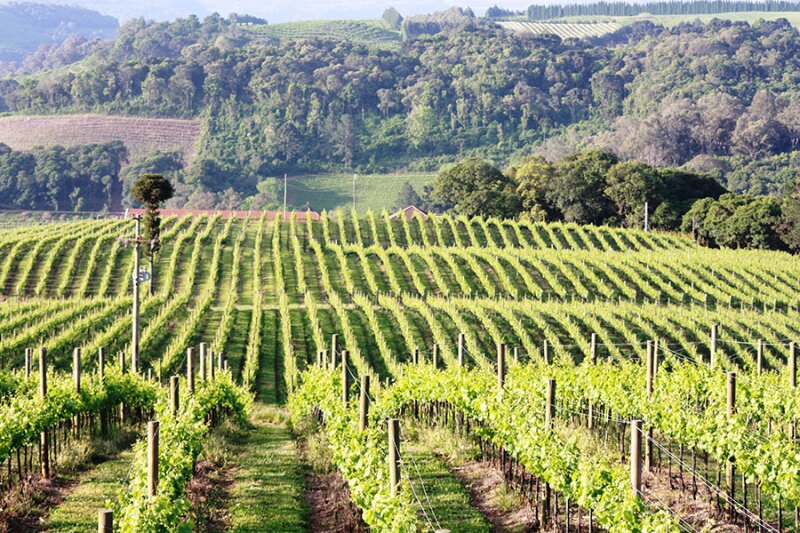The Southern Hemisphere is world-renowned for its wines from Chile, Argentina, New Zealand, Australia, and South Africa. But Brazil—famous for Ipanema and Copacabana, not malbec and sauvignon blanc—remains a quiet underdog, despite the fact that it’s the fifth-largest wine producer in the Southern Hemisphere (ahead of New Zealand). Although dominated by rainforests, nearly 200,000 acres of the country are covered in vineyards and more than 1,000 wineries are in operation. So every February, while most of Brazil and its beach-seeking tourists are in a constant state of Carnival, those living and working in the Serra Gaúcha wine region, located in the southernmost state Rio Grande do Sul, are putting in long days harvesting grapes. A wide array of still wines, such as merlot, chardonnay, cabernet franc, and tannat are made—but there’s another kind where Brazil truly, well, sparkles.
If Brazil were a wine, it would most certainly be bubbly, so it’s fitting that this vibrant, joyful and celebratory country is currently emerging as the world’s next big sparkling wine destination. Just ask Moët & Chandon. Recognizing Brazil’s potential for making quality sparkling wine decades ago, the French company opened Brazil Chandon in 1973.
The goal of Brazil’s winemakers is to embody Brazilian culture in the glass, so the country’s wines, especially the sparkling ones, are food friendly and easy to drink. They tend to be light, dry (not sweet), uber-refreshing, and fruit forward. Producers employ three different methods, but Brazil’s highest-quality sparklings are made using the traditional method (meaning it underwent a second fermentation in the bottle), the same used by producers of champagne and cava. But consider this: Brazil’s uncharted sparkling wine trail offers the rare chance to discover a wine destination before most of the world catches on. Besides, the exchange rate is tough to beat. Here’s how to do it.

The rolling vineyards at Cave Geisse
Courtesy of Cave Geisse
Where to Taste
Cave Geisse
Cave Geisse focuses 100 percent of its efforts on producing exceptional sparkling wines, with aging periods that range from 12 months to 15 years. Chilean founder Mario Geisse first arrived in the country when he was hired to launch Chandon’s Brazil branch, and he later used that experience for his own high-end pursuit. Book the Geisse experience, a wild, off-road ATV adventure that takes you up and through an actual jungle (complete with a waterfall) and ends with a top-of-the-mountain tasting set in the panoramic estate vineyards.
Salton Winery
Founded in 1910, Salton Winery is one of Brazil’s oldest wineries, run today by the family’s third generation. Brazil’s top sparkling wine producer, it accounts for 40 percent of the market, so touring this winery can feel akin to touring a factory until you wander the dark labyrinth of underground stone caves. Follow the lantern to a hidden tasting enclave with a medieval, King Arthur–inspired round table.
Don Giovanni
No big tour buses here. This boutique family winery founded in 1979 offers a highly personalized experience, including a hike through its scenic estate vineyards, a peek into the tiny cellar and caves, and an intimate wine tasting that showcases its premium traditional method sparklings.

Salton winery, Brazil’s top sparkling wine producer and one of the country’s oldest wineries
Courtesy of Salton Winery
Where to Eat
Coined the Tuscany of the Southern Hemisphere, the Serra Gaúcha region is heavily populated by Italian immigrants who sought refuge in Brazil in the 1800s and brought with them vine cuttings to make their own wine as they did back home. As a result, the region is home to some of the most authentic and delicious Italian cuisine outside of Italy. Hearty meals at Canta Maria and Mamma Gema will be worth every last calorie.
Where to Stay
Because the Serra Gaúcha region is fairly new to wine tourism, don’t expect the level of luxury that regions like Napa Valley are known for (at least, not yet). What you will find are quaint, modest, and remarkably affordable abodes. A family-friendly country resort, Hotel Villa Michelon evokes a sort of summer camp nostalgia, offering tennis, soccer, hiking, and ATV tours right on site. You’ll want to book Hotel & Spa do Vinho, a Marriott Autograph Collection hotel, for the “wine spa” alone, featuring an indoor and outdoor pool, steam room, and rejuvenating treatments, including massages, facials, and body scrubs. Or sleep at a winery; just steps outside its cellar doors, Don Giovanni operates a rustic eight-room bed-and-breakfast with a pool and vineyard views.
>>Next: This Little Region Is the Easiest Wine Country Weekend Getaway











